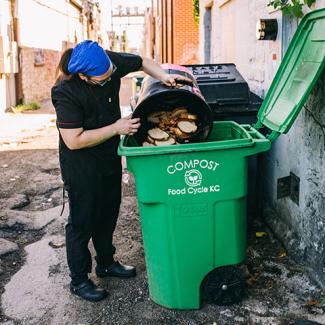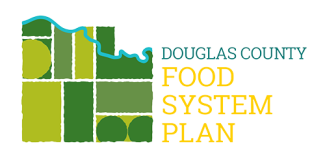Goal #3: We build and design our communities to ensure food access, foster health, and eliminate food deserts
The physical environment that creates our communities is often called the built environment. The way we design and maintain our built environment influences how we can access food.
The Objectives and Policies in Goal 3 suggest actions that the community can support to increase access to healthy food through our transportation network, our food-growing spaces, and our food retail stores. Ensuring healthy food access is essential to creating an inclusive local food system that benefits all Douglas County residents.
The indicators below can help us track our progress in achieving this goal:
Number of Douglas County residents living in low-income / low-access census tracts
Overview
This data shows the population count within low-income census tracts where a significant number of residents is more than 1 mile (urban) or 10 miles (rural) from the nearest supermarket. This was the previous definition of the term “food desert” referenced in the plan. Low-income census tracts are defined as tracts with a poverty rate of 20% or higher, or tracts with a median family income less than 80% of median family income for the state or metropolitan area. Since 2010, the number of low-income residents lacking access to food has increased by 1,572.
About the Data
Source: USDA Food Research Atlas
Update Frequency: Every 4-5 years
Notes: Estimates in the USDA Food Research Atlas for 2019 are based on a 2019 list of supermarkets, the 2010 Decennial Census, and the 2014-2018 American Community Survey (ACS). The estimates for 2015 are based on a 2015 list of supermarkets, the 2010 Decennial Census, and the 2010-2014 ACS.
Number of food outlets per 1,000 people in Douglas County
Overview
This is the number of food outlets in Douglas County per 1,000 people in 2011 and 2016. Food outlets include grocery stores, convenience stores, and fast food restaurants.
About the Data
Source: USDA Food Environment Atlas
Update Frequency: Every 5 years
Notes: Store data are from the U.S. Department of Commerce, Bureau of the Census, County Business Patterns. Population data are from the U.S. Department of Commerce, Bureau of the Census, Population Estimates. Grocery stores (defined by NAICS code 445110) include establishments generally known as supermarkets and smaller grocery stores primarily engaged in retailing a general line of food, such as canned and frozen foods; fresh fruits and vegetables; and fresh and prepared meats, fish, and poultry. Establishments known as convenience stores or food marts (defined by NAICS codes 445120 and 447110) are primarily engaged in retailing a limited line of goods that generally includes milk, bread, soda, and snacks. Limited-service restaurants (defined by NAICS code 722211) include establishments primarily engaged in providing food services (except snack and non-alcoholic beverage bars) where patrons generally order or select items and pay before eating. Food and drink may be consumed on premises, taken out, or delivered to the customer location. Some establishments in this industry may provide these food services in combination with alcoholic beverage sales.
NAICS stands for North American Industry Classification System. The federal government uses this system to categorize types of businesses in order to analyze economic data related to each sector.
Food access locations in the City of Lawrence
Overview
This interactive map shows the food access locations in the City of Lawrence. In addition, it includes layers to highlight key aspects of food access: geographic (i.e. bus stops, walkability, etc.) and financial factors (i.e. low-income census tracts). The map also includes an analysis of the Transportation Disadvantaged population. People who are transportation disadvantaged experience challenges achieving basic access to services, employment, and/or education. Not only do socio-demographic characteristics factor into being transportation disadvantaged, but also where people live and what travel options are available to them. In the map, users can turn on and off different layers to understand food access challenges in their neighborhood.
About the Data
Source: City of Lawrence
Update Frequency: Every 2 years
Notes: This map was created by the City of Lawrence. It was last updated in 2022.
Number of Lawrence Transit stops within a 1/4 mile, 1/2 mile, 3/4 mile, and 1 mile walkshed of a healthy food access site
Overview
This data comes from the Food Access Locations map maintained by the City of Lawrence. This indicator shows the number of bus stops within various walking distances of a food access site.
About the Data
Source: Lawrence-Douglas County Public Health, City of Lawrence
Update Frequency: Every 2 years
Notes: This data was compiled by the City of Lawrence Metropolitan Planning Organization (MPO) and Geographic Information Systems (GIS) staff. It was last updated in 2022.
Number of living units in the City of Lawrence within a 1/4 mile, 1/2 mile, 3/4 mile, and 1 mile walkshed of a grocery store or culturally-specific market
Overview
This data comes from the Food Access Locations map maintained by the City of Lawrence. This indicator helps understand food access by showing walking distance from living units to grocery stores and culturally-specific markets. A living unit is defined as any room or group of rooms designed as the living quarters of one family or household.
About the Data
Source: Lawrence-Douglas County Public Health, City of Lawrence
Update Frequency: Every 2 years
Notes: This data was compiled by the City of Lawrence Metropolitan Planning Organization (MPO) and Geographic Information Systems (GIS) staff. It was last updated in 2022.
Number of living units in the City of Lawrence a 1/4 mile, 1/2 mile, 3/4 mile, and 1 mile walkshed of a community garden
Overview
This data comes from the Food Access Locations map maintained by the City of Lawrence. This indicator helps understand access to food-growing spaces by showing walking distance from living units to a community garden. A living unit is defined as any room or group of rooms designed as the living quarters of one family or household.
About the Data
Source: Lawrence-Douglas County Public Health, City of Lawrence
Update Frequency: Every 2 years
Notes: This data was compiled by the City of Lawrence Metropolitan Planning Organization (MPO) and Geographic Information Systems (GIS) staff. It was last updated in 2022.
Community Voices

Growing Common Ground to New Heights
In 2017, when the Douglas County Food System Plan (FSP) was first adopted, Common Ground, the City of Lawrence’s urban gardening and farming program, was already an established and robust effort.

Dining Out on “Purposeful Plates”
In early 2019, members of the Douglas County Food Policy Council (DCFPC) Goal 5 working group, which focuses on eliminating food waste through reduction, recovery, and diversion, partnered with Dr. Susan Harvey from The University of Kansas...

